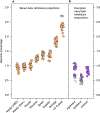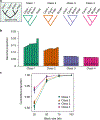Partial genomic survival of cave bears in living brown bears
- PMID: 30150744
- PMCID: PMC6590514
- DOI: 10.1038/s41559-018-0654-8
Partial genomic survival of cave bears in living brown bears
Abstract
Although many large mammal species went extinct at the end of the Pleistocene epoch, their DNA may persist due to past episodes of interspecies admixture. However, direct empirical evidence of the persistence of ancient alleles remains scarce. Here, we present multifold coverage genomic data from four Late Pleistocene cave bears (Ursus spelaeus complex) and show that cave bears hybridized with brown bears (Ursus arctos) during the Pleistocene. We develop an approach to assess both the directionality and relative timing of gene flow. We find that segments of cave bear DNA still persist in the genomes of living brown bears, with cave bears contributing 0.9 to 2.4% of the genomes of all brown bears investigated. Our results show that even though extinction is typically considered as absolute, following admixture, fragments of the gene pool of extinct species can survive for tens of thousands of years in the genomes of extant recipient species.
Figures



Similar articles
-
Ancient DNA reveals differences in behaviour and sociality between brown bears and extinct cave bears.Mol Ecol. 2016 Oct;25(19):4907-18. doi: 10.1111/mec.13800. Epub 2016 Sep 6. Mol Ecol. 2016. PMID: 27506329
-
Genomic Evidence of Widespread Admixture from Polar Bears into Brown Bears during the Last Ice Age.Mol Biol Evol. 2018 May 1;35(5):1120-1129. doi: 10.1093/molbev/msy018. Mol Biol Evol. 2018. PMID: 29471451
-
Ancient DNA analyses reveal high mitochondrial DNA sequence diversity and parallel morphological evolution of late pleistocene cave bears.Mol Biol Evol. 2002 Aug;19(8):1244-50. doi: 10.1093/oxfordjournals.molbev.a004185. Mol Biol Evol. 2002. PMID: 12140236
-
Impacts of Human Recreation on Brown Bears (Ursus arctos): A Review and New Management Tool.PLoS One. 2016 Jan 5;11(1):e0141983. doi: 10.1371/journal.pone.0141983. eCollection 2016. PLoS One. 2016. PMID: 26731652 Free PMC article. Review.
-
Sequencing and assembling bear genomes: the bare necessities.Front Zool. 2022 Nov 30;19(1):30. doi: 10.1186/s12983-022-00475-8. Front Zool. 2022. PMID: 36451195 Free PMC article. Review.
Cited by
-
Comparative analysis of microsatellites in coding regions provides insights into the adaptability of the giant panda, polar bear and brown bear.Genetica. 2022 Dec;150(6):355-366. doi: 10.1007/s10709-022-00173-7. Epub 2022 Oct 26. Genetica. 2022. PMID: 36287311
-
Genomic variation from an extinct species is retained in the extant radiation following speciation reversal.Nat Ecol Evol. 2022 Apr;6(4):461-468. doi: 10.1038/s41559-022-01665-7. Epub 2022 Feb 24. Nat Ecol Evol. 2022. PMID: 35210577
-
Recent introgression between Taiga Bean Goose and Tundra Bean Goose results in a largely homogeneous landscape of genetic differentiation.Heredity (Edinb). 2020 Aug;125(1-2):73-84. doi: 10.1038/s41437-020-0322-z. Epub 2020 May 26. Heredity (Edinb). 2020. PMID: 32451423 Free PMC article.
-
The Legacy of Recurrent Introgression during the Radiation of Hares.Syst Biol. 2021 Apr 15;70(3):593-607. doi: 10.1093/sysbio/syaa088. Syst Biol. 2021. PMID: 33263746 Free PMC article.
-
Historical biogeography of the leopard (Panthera pardus) and its extinct Eurasian populations.BMC Evol Biol. 2018 Oct 23;18(1):156. doi: 10.1186/s12862-018-1268-0. BMC Evol Biol. 2018. PMID: 30348080 Free PMC article.
References
-
- Shurtliff QR Mammalian hybrid zones: a review. Mamm. Rev. 43, 1–21 (2013).
Publication types
MeSH terms
Grants and funding
LinkOut - more resources
Full Text Sources
Other Literature Sources
Miscellaneous

